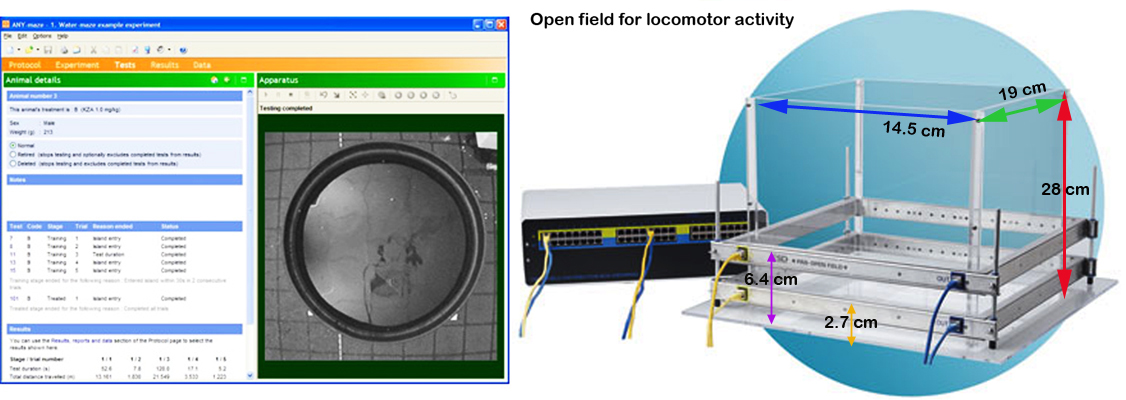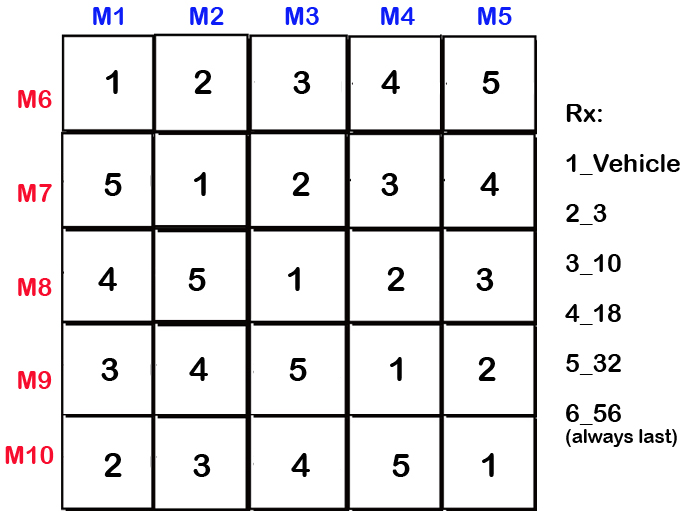Thomsen1 project protocol
Drug study: Psychomotor stimulant effects of cocaine in 15 mouse strains (2011)
Thomsen M, Caine SBProject protocol — Contents
Workflow and sampling
Equipment and supplies
Reagents and solutions
Procedures
Definitions
Data
ReferencesWorkflow
Mice introduced to the testing chamber for 3 daily habituation sessions (Fig. 1) Cocaine test series 1: vehicle, 3, 10, 18, 32, and 56 mg/kg administered at least 2 days apart, with mice acclimated 1h prior to injection and assessed for locomotor activity the remaining 3h Cocaine test series 2: vehicle, 3, 10, and 32 mg/kg administered at least 2 days apart, with mice acclimated 1h prior to injection and assessed for locomotor activity the remaining 3h Figure 1. Timeline for cocaine tests according to a Latin square design.
- Open field chambers: Clear plastic chambers 41.5 X 19 X 28 cm (l X w X h) loosely lined with pine shavings (to absorb urine), fitted with filter tops and placed within Photobeam Activity System monitoring frames (San Diego Instruments, San Diego, CA) were used to assess locomotor activity. Infrared beams were transmitted through the cage 2.7 cm above the floor for assessment of horizontal activity (repeated and consecutive beam breaks). Additional beams measured vertical activity (rearing), at 6.4 cm above the floor (Fig. 2).
- Balance scale
- Needles and syringes
- Cleaning supplies
- Saline solution (0.9% NaCl)
- Cocaine hydrochloride (National Institute on Drug Abuse/National Institutes of Health)
- Alkaline detergent for cleaning
Acclimation to test conditions
Mice are allowed to habituate to testing conditions for at least 1 h before testing.
Procedure for testing cocaine dose effects on locomotor activity
a. Mice are introduced to the test chambers for 3 daily habituation sessions (no injections, Fig. 1).
b. On each test day, mice are allowed to acclimate to test chambers for 1h.
c. Mice are removed for injection with vehicle or varying doses of cocaine (dissolved in 0.9% saline; 10 mL/kg i.p.) according to a Latin square design (Fig. 1 and Fig. 3). The highest dose (56 mg/kg) is always administered last.
d. Mice are returned to the test chamber for the remaining 3h of the session for locomotor activity assessment.
e. Data are collected in 10-min bins for each session. Total beam breaks (horizontal and vertical) are collapsed across time.
f. After each session, mice are returned to their home cage and allowed to rest. Test days are always separated by at least 2 days.
g. In between sessions, the open field chamber is cleaned with water and disinfectant.Drug test series 1: 0, 3, 10, 18, 36, and 56 mg/kg cocaine
Drug test series 2: 0, 3, 10, 32 mg/kg cocaine
Notes by submitting PI: "...In the few cases where mice did not tolerate the high dose of drug, all data were excluded for these animals (i.e., a subject was removed from the study when seizures or clear pre-seizure symptoms were observed: the subject was then removed from the test chamber, "rescued" with a 5–10 mg/kg diazepam injection intraperitoneally, and returned to its home cage for observation and recovery)..."
Habituation: 3 consecutive days within the test chamber with no treatment injections.
Acclimation period: the first hour in a 4h test session in the test chamber before injection.
Latin square design: sequential method of drug administration where each mouse is given a different series of drug doses (Fig. 3).
Figure 3. Latin square design treatment schedule, example for 10 mice (M1-10).Data collected by investigator
Cocaine test series 1, locomotor activity:
cocaine mg/kg i.p.
- 0 (baseline)
- 3
- 10
- 18
- 32
- 56
Cocaine test series 2, locomotor activity:
cocaine mg/kg i.p.
- 0 (baseline)
- 3
- 10
- 32


